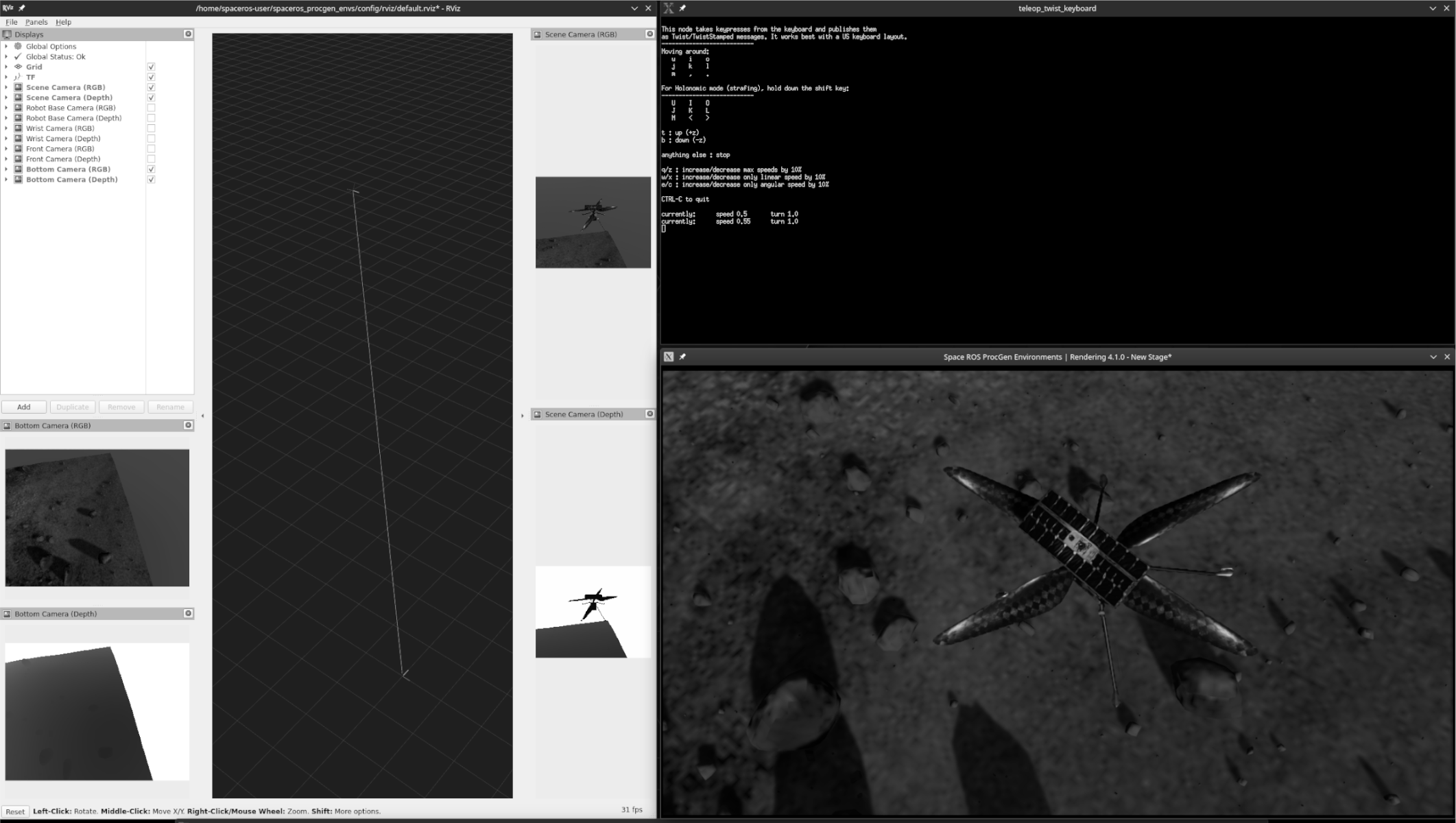Space ROS Integration
After understanding the basic usage and running parallel environments, we now explore how to integrate these environments with Space ROS, enabling control of the robots and data collection over ROS topics.
Single Environment
The run_spaceros.py script is the primary entry point for interfacing with the environments through Space ROS. This script spawns a single ROS node that maps inputs and outputs for the environment and provides miscellaneous functionalities such as resetting the simulation. Here is an example using the Ingenuity demo:
spaceros_procgen_envs/run.sh ros2 run spaceros_procgen_envs run_spaceros.py --demo ingenuity
Once the environment is initialized, open a new terminal to inspect the available ROS topics. You can either use your ROS setup or join the running Docker container with the join.sh script:
spaceros_procgen_envs/join.sh
Now, list the available ROS topics:
ros2 topic list
# Expected output:
# /clock
# /env/info
# /env/reward
# /env/terminated
# /env/truncated
# /parameter_events
# /robot/cmd_vel
# /rosout
# /tf
To control the robot, publish a Twist message to the /robot/cmd_vel topic:
ros2 topic pub --once /robot/cmd_vel geometry_msgs/msg/Twist '{linear: {x: 1.0}}'
You can reset the simulation by calling the /sim/reset service:
ros2 service call /sim/reset std_srvs/srv/Empty
Parallel Environments
You can run multiple environments in parallel by using the --num_envs argument. Each environment will map to its own ROS namespace. For example, try running the Ingenuity demo with 4 environments:
spaceros_procgen_envs/run.sh ros2 run spaceros_procgen_envs run_spaceros.py --demo ingenuity --num_envs 4
List the available ROS topics again:
ros2 topic list
# Expected output:
# /clock
# /env0/reward
# /env0/robot/cmd_vel
# /env0/terminated
# /env0/truncated
# /env1/reward
# /env1/robot/cmd_vel
# /env1/terminated
# /env1/truncated
# /env2/reward
# /env2/robot/cmd_vel
# /env2/terminated
# /env2/truncated
# /env3/reward
# /env3/robot/cmd_vel
# /env3/terminated
# /env3/truncated
# /envs/info
# /envs/robot/cmd_vel
# /parameter_events
# /rosout
# /tf
Each environment has its own namespace, allowing individual control. For example:
ros2 topic pub --once /env0/robot/cmd_vel geometry_msgs/msg/Twist '{linear: {x: -1.0}}'
ros2 topic pub --once /env1/robot/cmd_vel geometry_msgs/msg/Twist '{linear: {x: 1.0}}'
ros2 topic pub --once /env2/robot/cmd_vel geometry_msgs/msg/Twist '{linear: {y: -1.0}}'
ros2 topic pub --once /env3/robot/cmd_vel geometry_msgs/msg/Twist '{linear: {y: 1.0}}'
Launch with rviz2 and teleop_twist_keyboard
For convenience, you can launch rviz2 alongside run_spaceros.py and teleop_twist_keyboard for visualization and control via keyboard:
spaceros_procgen_envs/run.sh ros2 launch spaceros_procgen_envs demo.launch.py task:=ingenuity_visual num_envs:=4
